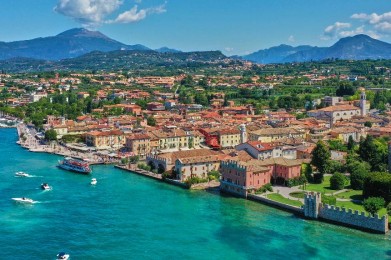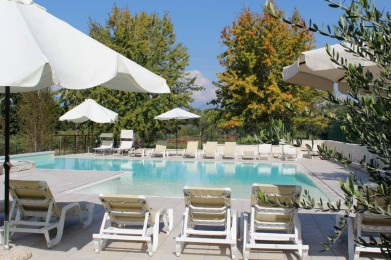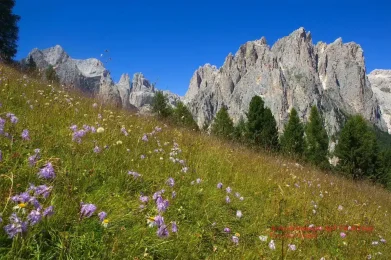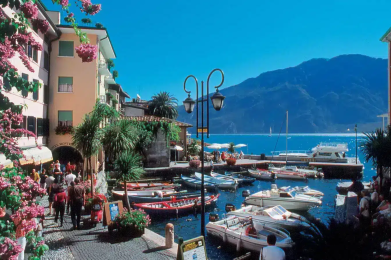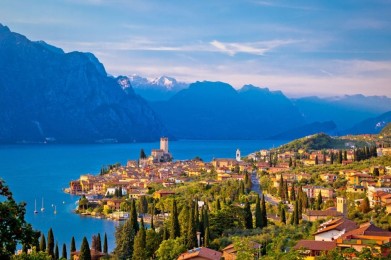The origins of the Scaliger Castle of Lazise date back to the ninth century, when the inhabitants of the village erected early defenses to protect themselves from Hungarian invasions, completed by the end of the following century, as evidenced by the privilege granted in 983 by the Emperor of the Holy Roman German Empire Otto II, in which he empowered the local population to complete their defenses.
In 1193 the castle and the town came under the rule of the free Commune of Verona and then, a few years later, under the Seigniory of the Scaligeri, who had by then centralized power in the town in their hands: Alberto II and Mastino II della Scala in 1329 renovated the walls of the village, interspersing them with some twenty scudate towers, while the reconstruction of the fortress was begun by Cansignorio in 1375 and completed by Antonio and Bartolomeo II in 1381; Lazise thus became a stronghold of the western Veronese fortified chessboard.
The lakeside village of Lazise is equipped with a large part of the city walls, of which only the northernmost part of the eastern curtain wall and the part of the western curtain wall that, starting from the castle, continued along the lake to the ancient harbor, ending in the vanished Cadenon tower has been lost, eliminated in 1939 to make way for the war memorial, but whose figure has remained in the memory of the Lacisi community so much so that it continues to exist in the popular festival known as the Palio della Cuccagna del Cadenon, which takes place every year right where the medieval tower stood.
The actual fortress was built between 1375 and 1381, so it belongs to a series of defensive works begun by Cansignorio and completed by the last two Scaligeri, Antonio and Bartolomeo II della Scala. It consists of two side-by-side enclosures: a larger rectangular curtain wall, used as a military port, on the side facing the lake, and a smaller rectangular one, the parade ground, on the side facing inland: both curtains are interspersed with six scudate towers, with masonry vaults supporting the crenellated terraces and wooden structures supporting the intermediate floors; there are four corner and two intermediate towers located on the long side, surrounded both toward the countryside and the built-up area by a large water moat equipped with a masonry counterscarp and, on the countryside side, also by a counter ditch. There are two entrances to the castle, one toward the countryside and one toward the town, both protected by a ravelin equipped with double doors and a drawbridge over a moat. In addition, to provide greater defense of the castle, a second curtain wall, slightly lower than the main one, unraveled on either side of the ravelin toward the countryside.
Particularly imposing is the castle keep made of terracotta bricks, with a two-meter-high stone basement and a crowning formed by a crenellated hanging structure, with machicolations on arches discharging their weight onto a triple sloping stone shelf. This ultimate element of defense could be accessed from the patrol walk via a small drawbridge: from the floor reached one could then descend via trap doors to the dungeons, or via stairs ascend to the floors above. At the base of the keep, inside the parade ground, once stood the castellan’s residence and the militia barracks, close to the city wall.
The romantic park designed by Count Buri unfolds as a path around the castle, the only major episode marking the way, with no other surprise elements. Of the original essences many survive to this day: particularly significant for their size and beauty are a wellingtonia, a sequoia and two specimens of Magnolia grandiflora, which are of such a size that their foliage merges, creating a green gallery under which the path unfolds. Instead, on the margins of la mara, in the southern portion of the garden, grow numerous deciduous plants, such as horse chestnuts, plane trees, lindens, black hornbeams, elms and oaks, while in the undergrowth are maples, hawthorns, pittosporum, laurels, yews and box trees, invigorated by the waters of the stream that collects the waters of the hills surrounding Lazise and which, in the very park of the villa, flow into the lake.

